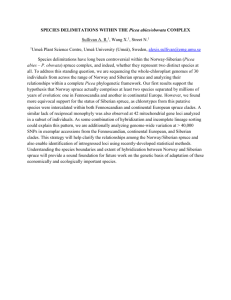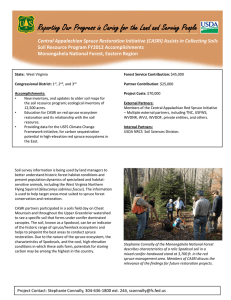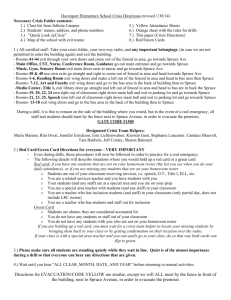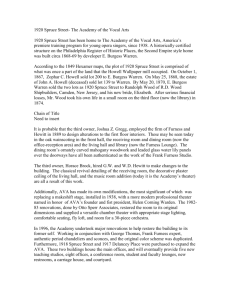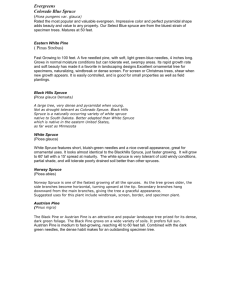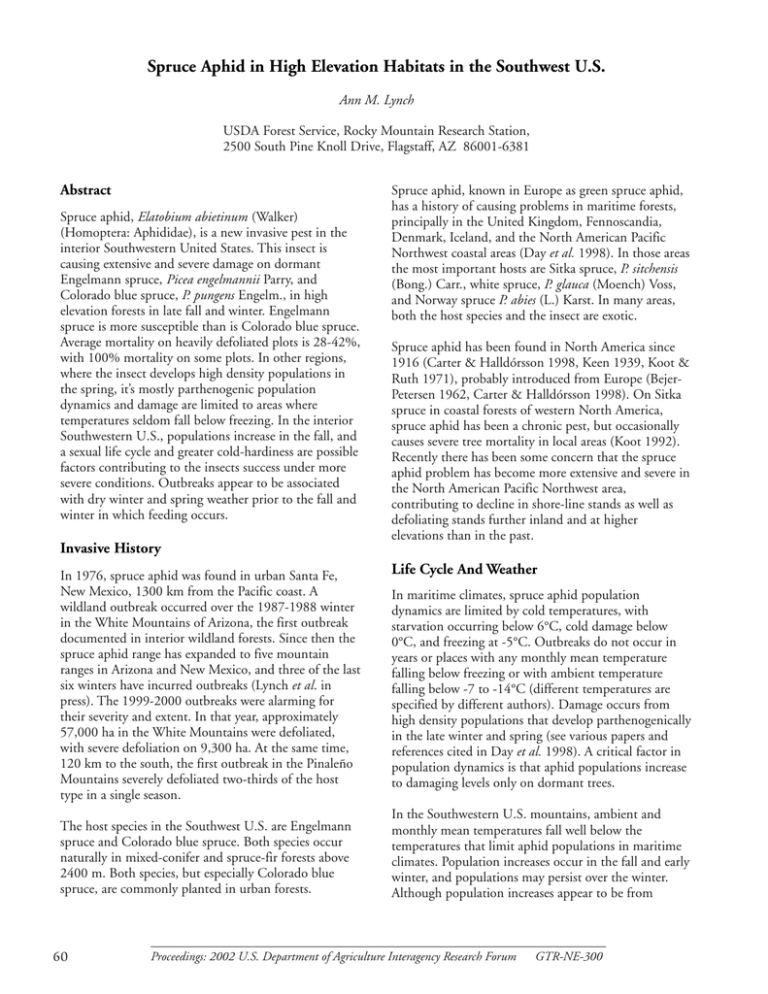
Spruce Aphid in High Elevation Habitats in the Southwest U.S.
Ann M. Lynch
USDA Forest Service, Rocky Mountain Research Station,
2500 South Pine Knoll Drive, Flagstaff, AZ 86001-6381
Abstract
Spruce aphid, Elatobium abietinum (Walker)
(Homoptera: Aphididae), is a new invasive pest in the
interior Southwestern United States. This insect is
causing extensive and severe damage on dormant
Engelmann spruce, Picea engelmannii Parry, and
Colorado blue spruce, P. pungens Engelm., in high
elevation forests in late fall and winter. Engelmann
spruce is more susceptible than is Colorado blue spruce.
Average mortality on heavily defoliated plots is 28-42%,
with 100% mortality on some plots. In other regions,
where the insect develops high density populations in
the spring, it’s mostly parthenogenic population
dynamics and damage are limited to areas where
temperatures seldom fall below freezing. In the interior
Southwestern U.S., populations increase in the fall, and
a sexual life cycle and greater cold-hardiness are possible
factors contributing to the insects success under more
severe conditions. Outbreaks appear to be associated
with dry winter and spring weather prior to the fall and
winter in which feeding occurs.
Invasive History
In 1976, spruce aphid was found in urban Santa Fe,
New Mexico, 1300 km from the Pacific coast. A
wildland outbreak occurred over the 1987-1988 winter
in the White Mountains of Arizona, the first outbreak
documented in interior wildland forests. Since then the
spruce aphid range has expanded to five mountain
ranges in Arizona and New Mexico, and three of the last
six winters have incurred outbreaks (Lynch et al. in
press). The 1999-2000 outbreaks were alarming for
their severity and extent. In that year, approximately
57,000 ha in the White Mountains were defoliated,
with severe defoliation on 9,300 ha. At the same time,
120 km to the south, the first outbreak in the Pinaleño
Mountains severely defoliated two-thirds of the host
type in a single season.
The host species in the Southwest U.S. are Engelmann
spruce and Colorado blue spruce. Both species occur
naturally in mixed-conifer and spruce-fir forests above
2400 m. Both species, but especially Colorado blue
spruce, are commonly planted in urban forests.
60
Spruce aphid, known in Europe as green spruce aphid,
has a history of causing problems in maritime forests,
principally in the United Kingdom, Fennoscandia,
Denmark, Iceland, and the North American Pacific
Northwest coastal areas (Day et al. 1998). In those areas
the most important hosts are Sitka spruce, P. sitchensis
(Bong.) Carr., white spruce, P. glauca (Moench) Voss,
and Norway spruce P. abies (L.) Karst. In many areas,
both the host species and the insect are exotic.
Spruce aphid has been found in North America since
1916 (Carter & Halldórsson 1998, Keen 1939, Koot &
Ruth 1971), probably introduced from Europe (BejerPetersen 1962, Carter & Halldórsson 1998). On Sitka
spruce in coastal forests of western North America,
spruce aphid has been a chronic pest, but occasionally
causes severe tree mortality in local areas (Koot 1992).
Recently there has been some concern that the spruce
aphid problem has become more extensive and severe in
the North American Pacific Northwest area,
contributing to decline in shore-line stands as well as
defoliating stands further inland and at higher
elevations than in the past.
Life Cycle And Weather
In maritime climates, spruce aphid population
dynamics are limited by cold temperatures, with
starvation occurring below 6°C, cold damage below
0°C, and freezing at -5°C. Outbreaks do not occur in
years or places with any monthly mean temperature
falling below freezing or with ambient temperature
falling below -7 to -14°C (different temperatures are
specified by different authors). Damage occurs from
high density populations that develop parthenogenically
in the late winter and spring (see various papers and
references cited in Day et al. 1998). A critical factor in
population dynamics is that aphid populations increase
to damaging levels only on dormant trees.
In the Southwestern U.S. mountains, ambient and
monthly mean temperatures fall well below the
temperatures that limit aphid populations in maritime
climates. Population increases occur in the fall and early
winter, and populations may persist over the winter.
Although population increases appear to be from
Proceedings: 2002 U.S. Department of Agriculture Interagency Research Forum
GTR-NE-300
The production of cold-hardy eggs could explain
population persistence in mountain areas with cold
winters, but does not explain population increase
and survival during the fall. Aphid populations in
the Southwest U.S. are clearly surviving, increasing,
and causing severe defoliation and related tree
mortality under conditions that maritime
populations cannot. Mountain populations appear
to exhibit additional cold-hardiness than do
maritime populations. At this time I do not know what
contributes to the additional cold-hardiness, but suspect
a) that individuals develop more cold-hardiness under
fluctuating diurnal temperatures, b) that host foliage
chemistry may provide additional protection (aphids
lose some cold-hardiness after feeding on Sitka spruce,
and Engelmann spruce is much more cold-hardy than
Sitka spruce), or c) a genetic change has occurred.
Understanding the mechanisms behind spruce aphid
cold-hardiness is critical to determining how much of
the Engelmann spruce range is at risk from this insect.
In the mountains, there is a tendency for spruce aphid
outbreaks to follow dry winter and spring weather (Fig.
1). This tendency does not appear to be influenced by
the amount of moisture received later during the
summer monsoon. Spruce aphid populations increase
when the host trees are dormant, both in maritime
climate (in the spring) and in temperate climate (in the
fall). I speculate that minimal snowpack accumulation,
or early loss of snowpack, affects soil temperature such
that tree phenology is affected: early soil warming cause
trees to break dormancy early, subsequently causing
them to enter dormancy early in the fall. This would
provide dormant foliage as a food resource over a
sufficiently long, and relatively warm, period for
populations to increase before extremely low
temperatures occur. Also, moisture stress early in the
growing season might alter foliage chemistry so that it is
a more suitable food resource. In all likelihood,
susceptibility is related to a combination of factors
including prior winter and spring weather, autumn
temperature regimes, host response to previous feeding,
and the size of the pre-existing spruce aphid population.
35
Outbreak
30
Non-outbreak
Precipitation (cm)
parthenogenic reproduction, numerous sexual males
are produced each year, especially in early winter
(late November or December). I assume that coldhardy eggs are produced by the sexual forms, and
that this stage allows survival during the coldest
winter temperatures. A holocyclic life history
prevails in Scandinavia and in the native territory in
Germany, where the insect is mostly innocuous
(Bejer-Petersen 1962; Bevan 1966; Carter &
Halldórsson 1998).
25
20
15
10
5
0
DJF
JFM FMA MAM AMJ
MJJ
JJA
JAS
ASO SON OND
Three-month period
Figure 1.—Three-month running average of precipitation in
the White Mountains of Arizona, for years with and without
fall spruce aphid outbreaks (DJF through JJA would precede
the outbreak) (1981-2001). Triangles indicate significantly
different means (P < 0.10).
Tree and Stand Damage
Defoliation is variable from watershed to watershed,
with less variability within each stand. Individual tree
defoliation frequently approaches 100%. All size and
age classes of trees are affected, and Engelmann spruce is
more susceptible than Colorado blue spruce (Fig. 2).
On trees 4 cm or larger in dbh, tree size does not
influence the severity of defoliation (Fig. 2).
Quantitative data on regeneration size classes is
inadequate, but reconnaissance indicates that seedlings
and saplings are more severely defoliated than larger
trees. In the White Mountains, average plot mortality
on heavily defoliated plots (mean defoliation index of 6
or greater, a rating that indicated that all crown thirds
were 34% or more defoliated) was 28-42% three years
after defoliation, with 100% mortality on some plots.
On an individual tree basis, those most likely to die
(67% mortality) were spruce of either species with
severe defoliation plus heavy infections of spruce dwarf
mistletoe, Arceuthobium microcarpum (Engelmann)
Hawksworth & Wiens (Viscaceae).
Management concerns include resource values affected
by tree mortality (particularly timber and recreation),
increased risk of wildfire, increased risk of bark beetle
outbreak, and impacts to wildlife habitats. In the long
run, the possibility of repeated events leads to concerns
about the loss of established regeneration and
anticipated failure of defoliated trees to set viable seed,
and subsequent effects on tree population dynamics.
Proceedings: 2002 U.S. Department of Agriculture Interagency Research Forum
GTR-NE-300
61
Mean tree defoliation index
CO blue spruce
Engelmann spruce
7
6
5
4
3
2
1
0
<5
8
12
16
20
Diameter class (4 in =10 cm)
Future Prospects
If outbreak frequency is low, then many trees should be
able to survive and reproduce. Spruce aphid feeds on
foliage that was produced in the growing season prior to
autumn feeding (years n-1, n-2, etc.). The current year’s
foliage (year n) is not a suitable food resource until at
least late autumn. This feeding pattern allows trees to
gather nutrients and set buds prior to defoliation. In
some less severe episodes, not all of the year n foliage is
lost. Therefore, in year n+1, buds will flush on surviving
trees and branches, and some of year n foliage might be
retained as well, providing a photosynthetic base until
the next defoliation episode. The fate of spruce,
particularly Engelmann spruce, is dependent upon the
frequency of spruce aphid outbreaks. Repetitive
outbreaks will result in extensive mortality, loss of
established regeneration, and loss of reproductive
potential. Outbreaks can occur two years in a row in the
same general area, but I do not yet know if the same
trees are heavily defoliated in both outbreaks.
Research is needed on this insect, focusing on insect
biology, population dynamics, insect-host physiology,
impact, disturbance ecology, and host resistance.
Population dynamics on interior host species under
mountain conditions are obviously different than
population dynamics on coastal species under maritime
climatic conditions. The association of epizootic
population behavior with prior weather conditions
makes it likely that outbreaks can be predicted 6
months in the future with good confidence, and even
longer with less confidence. Such prediction would
require a more detailed model than “aphid outbreaks
tend to follow dry winters”, but is realistically attainable
and would allow managers take protective action. This
information would also allow us to evaluate the
frequency of outbreaks that is likely under
62
24
28
Figure 2.—Defoliation of spruce with
dbh of 4 cm or greater in the White
Mountains. Over the 1996-1997
outbreak. Defoliation Index is a sum
of three ratings, where each crown
third is rated as 0, 1, 2, or 3, by 33%
defoliation (an index of 9 indicates that
each crown third was 67-100%
defoliated).
contemporary climatic patterns. Population dynamics
need to be modeled in both ecosystems, and the weather
and cold hardiness mechanisms determined Insect-host
interaction research should focus on insect coldhardiness and reproductive capacity and on foliage
phenology, chemistry, and seasonal suitability as a food
resource. Sap sucking causes additional tree damage
than does defoliation from a leaf chewing insect, as the
tree replenishes and subsequently loses more sap before
the needles die. Impact assessment studies need to
quantify the relationships between feeding pressure,
needle death, and tree mortality. A metric for relating a
relatively easy field observation to the likelihood of tree
mortality is needed. Local risk and hazard conditions as
well as geographic areas of the host range that are at risk
need to be identified. The impact of defoliation on seed
production and viability needs to be known in order to
project long-term effects of this new disturbance agent
to mixed-conifer and spruce-fir disturbance ecology.
Resistant trees should be identified (there appear to be
some, but spruce beetle outbreaks threaten mature
individuals), and used either for developing planting
stock or for a tree improvement program. Also, coastal
aphid populations should be evaluated to determine if
the greater extent and severity of damage seen in those
areas is due to altered population genetic character or to
weather patterns.
This insect will likely impact the natural disturbance
regimes in mixed-conifer and spruce-fir forests. It will
alter fuels accumulation, bark beetle hazard, and future
stand development. Long-term stand effects may be
severe. Repeated defoliation events on all size classes of
trees will not only remove regeneration, but will in all
likelihood prevent viable seed from being produced. If
this is the case, Engelmann spruce representation in the
forest will be greatly diminished over time.
Proceedings: 2002 U.S. Department of Agriculture Interagency Research Forum
GTR-NE-300
Literature Cited
Bejer-Petersen, B. 1962. Peak years and regulation of
numbers in the aphid Neomyzaphis abietina
Walker. Oikos, (13): 155-168.
Bevan, D. 1966. The green spruce aphis Elatobium
(Neomyzaphis) abietinum Walker. Scottish Forestry
(20): 193-201.
Carter, C.; Halldórsson, G. 1998. Origins and
background to the green spruce aphid in Europe.
In: The Green Spruce Aphid in Western Europe:
Ecology, Status, Impacts and Prospects for
Management, ed. by K.R. Day & G. Halldórsson,
pp. 1-10. Forestry Commission Technical Paper 24,
Edinburgh.
Day, K.R.; Halldórsson, G.; Harding, S.; Straw, N.A.
Editors. 1998. The green spruce aphid in western
Europe: Ecology, status, impacts and prospects for
management. Forestry Commission Technical Paper
24. Forestry Commission, Edinburgh.
Keen, F.P. 1939. Insect enemies of western forests.
U.S. Dept. Agric. Miscellaneous Publication Number
273, issued 1938, slightly revised 1939. 210 p.
Washington D.C.
Koot, H.P. 1991. Spruce aphid. Forest Pest Leaflet,
Forestry Canada, Pacific Forestry Centre, Victoria,
B.C. 4 p.
Koot, H.P.; Ruth, D.S. 1971. Spruce aphid in British
Columbia. Forest Insect & Disease Survey Pest
Leaflet No. 16, Department of Fisheries and Forestry,
Canadian Forestry Service, Victoria, British
Columbia. 5 p.
Lynch, A.M.; Wilson, J.L.; Frank, M.S. In press.
Elatobium abietinum (Walker) populations reach
epidemic levels on Picea engelmannii Parry in the
interior southwestern United States. Agricultural
and Forest Entomology.
Proceedings: 2002 U.S. Department of Agriculture Interagency Research Forum
GTR-NE-300
63


